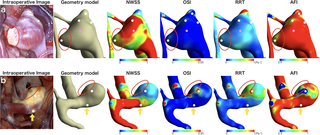PLOS ONE ( IF 2.9 ) Pub Date : 2018-01-16 , DOI: 10.1371/journal.pone.0191287 Kazuhiro Furukawa , Fujimaro Ishida , Masanori Tsuji , Yoichi Miura , Tomoyuki Kishimoto , Masato Shiba , Hiroshi Tanemura , Yasuyuki Umeda , Takanori Sano , Ryuta Yasuda , Shinichi Shimosaka , Hidenori Suzuki

|
Background & purpose
Hyperplastic remodeling (HR) lesions are sometimes found on cerebral aneurysm walls. Atherosclerosis is the results of HR, which may cause an adverse effect on surgical treatment for cerebral aneurysms. Previous studies have demonstrated that atherosclerotic changes had a correlation with certain hemodynamic characteristics. Therefore, we investigated local hemodynamic characteristics of HR lesions of cerebral aneurysms using computational fluid dynamics (CFD).
Methods
Twenty-four cerebral aneurysms were investigated using CFD and intraoperative video recordings. HR lesions and red walls were confirmed on the intraoperative images, and the qualification points were determined on the center of the HR lesions and the red walls. The qualification points were set on the virtual operative images for evaluation of wall shear stress (WSS), normalized WSS (NWSS), oscillatory shear index (OSI), relative residence time (RRT), and aneurysm formation indicator (AFI). These hemodynamic parameters at the qualification points were compared between HR lesions and red walls.
Results
HR lesions had lower NWSS, lower AFI, higher OSI and prolonged RRT compared with red walls. From analysis of the receiver-operating characteristic curve for hemodynamic parameters, OSI was the most optimal hemodynamic parameter to predict HR lesions (area under the curve, 0.745; 95% confidence interval, 0.603–0.887; cutoff value, 0.00917; sensitivity, 0.643; specificity, 0.893; P<0.01). With multivariate logistic regression analyses using stepwise method, NWSS was significantly associated with the HR lesions.
Conclusions
Although low NWSS was independently associated with HR lesions, OSI is the most valuable hemodynamic parameter to distinguish HR lesions from red walls.
中文翻译:

脑动脉瘤增生性病变的血流动力学特征
背景与目的
有时在脑动脉瘤壁上发现增生性改建(HR)病变。动脉粥样硬化是HR的结果,可能对脑动脉瘤的手术治疗产生不利影响。先前的研究表明,动脉粥样硬化的改变与某些血液动力学特征相关。因此,我们使用计算流体力学(CFD)研究了脑动脉瘤HR病变的局部血流动力学特征。
方法
使用CFD和术中视频记录对二十四例脑动脉瘤进行了研究。在术中图像上确认了HR病变和红壁,并在HR病变和红壁的中心确定了合格点。在虚拟手术图像上设置合格点,以评估壁切应力(WSS),归一化WSS(NWSS),振荡剪切指数(OSI),相对停留时间(RRT)和动脉瘤形成指标(AFI)。在鉴定点的这些血流动力学参数在HR病变和红壁之间进行了比较。
结果
与红墙相比,HR病变的NWSS较低,AFI较低,OSI较高且RRT延长。从接受者工作特性曲线的血流动力学参数分析来看,OSI是预测HR病变的最佳血流动力学参数(曲线下面积0.745; 95%置信区间0.603-0.887;临界值0.00917;敏感性0.643;阈值0.0053)。特异性0.893; P <0.01)。使用逐步方法进行多元逻辑回归分析,NWSS与HR病变显着相关。
结论
尽管低NWSS与HR病变独立相关,但OSI是区分HR病变与红壁的最有价值的血液动力学参数。











































 京公网安备 11010802027423号
京公网安备 11010802027423号